
Surf photography has been a topic rarely explored for some reason. Maybe it’s the difficulty of catching a surfer in action or the possibility of getting eaten by a shark, who knows? I have personally never surfed, but I’ve definitely taken on the task of photographing surfers. It is relatively easy once you follow a few surfing photography tips:
Table of Contents
As photographers, our job is based on manipulating and using light to our advantage on a day to day basis. When it comes to surf photography, you will notice where there is a lot of light to deal with. This may seem frightening at first, but don’t panic. First, examine as to how the light is hitting the water. There are often areas where the water is giving a constant reflection, and other areas where there is almost no reflection at all. For the best results, you should make it your duty to shoot the surfer in the direction with little to no reflection. This helps to recover your background and save you from those ugly, blown out skies that are hard to recover in post-production.
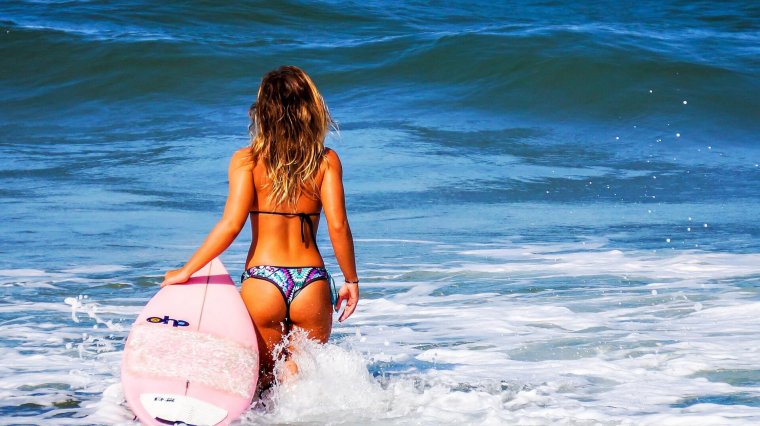
Try to keep your ISO as low as possible when shooting surfers. One of those reasons is to reduce the amount of noise in your image, as ISO levels highly contribute to it. Secondly, surf photography already offers so much light at your disposal, there is no need to add more and have overly exposed shot. Low ISO is the way to go when doing water photography.
Even though portrait orientation is welcomed, shooting horizontally makes for a far better shot. However, when shooting this way, try to be wary of the horizon in your background, as this can often throw the whole image off. It forces you to try and straighten it in post-production, which adds a bunch more work to your workflow. Shooting horizontally also helps capture those waves, and if you’re lucky, a nice sunset in the background.
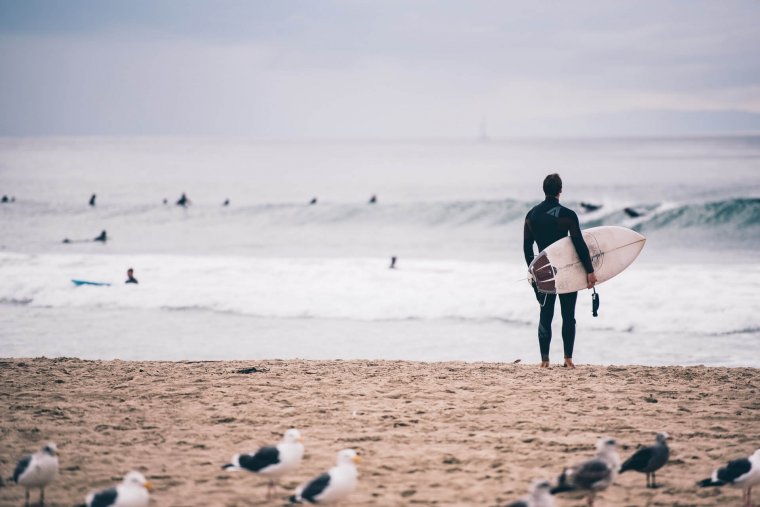
Surfing is a fast-paced action sport, and at any minute it can go from the person just chilling waiting on a wave, to them actually riding a wave. This all can happen in a matter of seconds, so it’s important to be ready. That’s why we recommend adjusting your shutter speed to 1/500 or above. This will help keep your images clean cut and sharp, canceling out any blur.
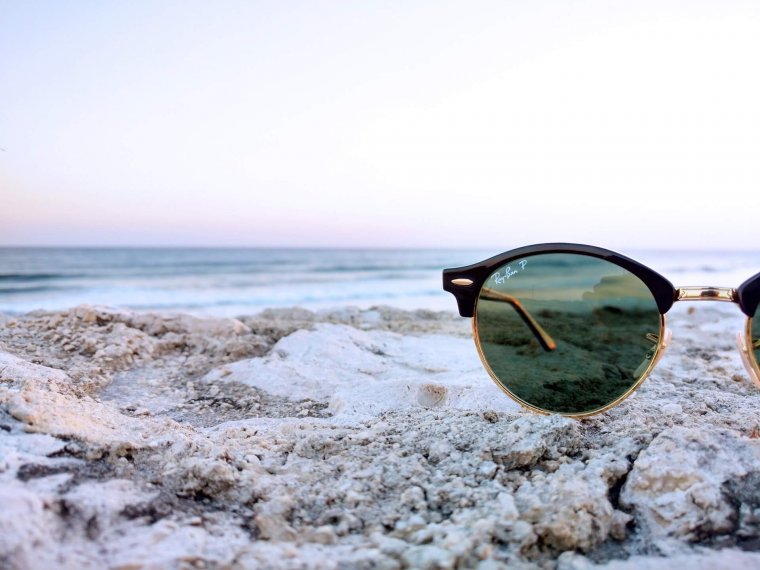
I can never stress enough how important it is to research your surf trip locations before the photo shoot. Surf Photography is a bit tricky in regards to location because not every beach or coast has proper waves for surfers to enjoy. Unless you have friends who are surfers, it is important to do some research to find where the hot spots in your vicinity are, so you may venture to them and get the shots you need. If you have surfer friends, then it becomes so much easier to find a good surf photography location, as they always know time, place, and season of when there will be some amazing waves to shoot.
They say a picture is worth a million words. I always encourage photographers to create a storyline through their images that captivate the viewer. Make it more than just about the amazing waves or that trick the surfer did. Always try to capture before and after images to create a storyline for viewers.
When you are looking to get the surf photos and wave photos that you want, it is all about the weather and the day that you are shooting in. You want everything to come together for the shots, and that can mean that the sun needs to be in the right spot and the waves need to be just right. Keep an eye on the weather, and once you know if the weather is going to work for you, then you can start planning what kind of equipment you want to use.
When the moment comes, get out and shoot your photos. If you are getting wave photos, get out there and just start taking pictures. The waves may not last forever, and you may only have a few minutes (an hour, at most) to get the photo you want. If you are getting pictures of surfers, then delaying can cost you some really great photos.
If you want to get great wave or surfer photos, you are going to need to get in the water. Obviously, you want to make sure your digital camera is completely protected, so consider investing in some weather proof gear. Do your research and get something really well-built.
You should try and get into the impact zone where the waves are going to crest the most. This is how you get a great photo of the surfer coming through the tube of the wave as it crests. Swim out with one of the surfers, and sit there waiting. The surfer will also wait and then when the wave comes, get ready to start snapping the photos.
If you have talked to the surfers about what you need, they will try and slow down so you can get the right photo, or speed up if that is what you are looking for. You may have to stay at the impact zone for a while, and you will probably take hundreds of photos just to get the right shot. Don’t leave that impact zone until you have what you want.
Before you come in from the water, take a look at your photos and see what they look like. You may get what you want immediately, or you may need to spend more time in the impact zone.
Also, don’t forget to try different angles. Get some shots from under the water looking up at the waves, attach a digital camera to a board if the surfer will allow it—whatever you can think of. Always look through your photos, and don’t leave until you get the photos you want.
If you’re new to surf photography, the idea of jumping into the impact zone with expensive gear can be nerve-racking. Surf photography has higher stakes, so it’s important to prepare by getting the right gear. Make sure to always double check your camera, accessories, and transportation before you leave shore.
No matter where you shoot, some photography principles remain the same. The best cameras on land are typically the best cameras in the sea. Be sure to look for cameras that have a high action shot rating. Surfers move fast, and water moves even faster. In order to capture crisp images, you need some power behind the lens. DSLR cameras are usually the best choice, due in large part to their versatility. They allow users to program settings in advance, which is very important when you’re using protective equipment. Even better, most of the newer products have lock features that prevent the settings from being jostled while the photographer is moving around. Since surf photography involves quite a lot of rough and tumble shooting, this little perk is a lifesaver.
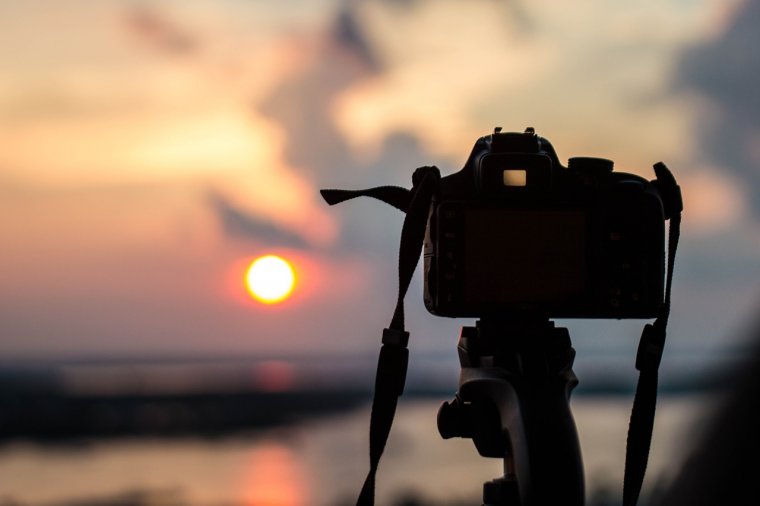
You’ll need a lens with enough focal length to capture your surfer. If you’re a Canon user like myself and don’t have access to anything more than your 300mm zoom kit lens, that’s not necessarily a problem, and you can still get the job done while you’re on shore—to an extent.
You won’t be able to change lenses easily once you get shooting. If you’re using underwater or double tow techniques, you won’t be able to change lenses at all until the session is over. While a variety of lenses are useful for capturing diverse shots, be sure you start with a few good wide angle and fisheye lenses. These capture the widest field of view, and it can be hard to focus on framing a shot when you’re in the middle of a wave.
One lens to consider is the Canon EF 100-400mm f/4.5-5.6 IS II USM lens. This lens is a joy to shoot with, as it provides the perfect edge to edge image quality and sharpness. The price tag might be a bit frightening at first, but make no mistake; it is worth the investment. You might even consider finding your nearest lens depot to see if it is available for rent so you can take it out for a spin first.
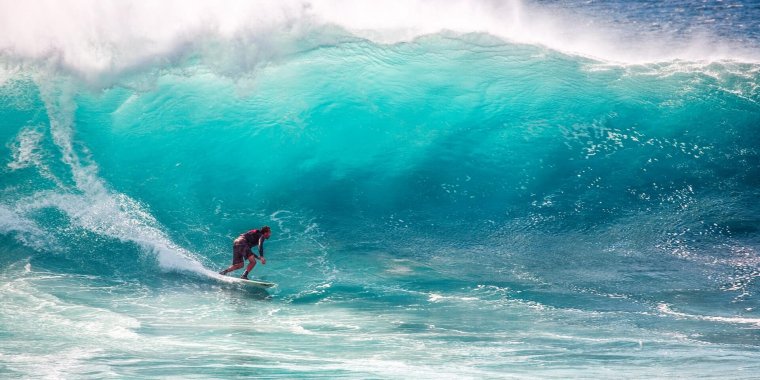
It shouldn’t surprise you that you’ll need some heavy duty water housing to protect your gear. This extra protection is always a good idea when you’re working around water, even if you’re shooting from a boat. There’s water housing for accessories like flashes, too. Flashes work well in surfing images, particularly in close-range work, like double-tow and underwater photography.
Make sure to research products carefully before buying, as not all water housing is designed to take the kind of punishment surf photography will deal it. Check to ensure your water housing is suitable for deep water, too. Many action cameras claim to be waterproof, for example, but can only handle depths up to a few feet.
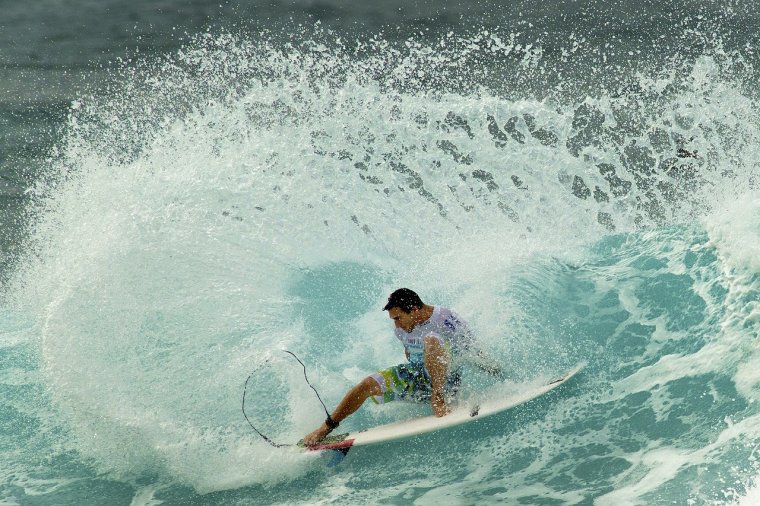
Before you hit the waves, test your equipment (preferably with an old camera) just in case the product is faulty. Try submerging your water housing with nothing inside first to see if there are obvious leaks, then move on to actual photography tests in your tub, pool, fish tank, etc. You’ll have enough to worry about when you’re in the ocean being paranoid over untested water housing.
Alternatively, you could also look into purchasing a waterproof camera. They don’t typically give you as much control as DSLRs, but they are more affordable and can be great to learn on.
Getting around as a surf photographer is very different from getting around on land. You can walk around your subject when you’re working on terrestrial photography, but it’s much more difficult to maneuver in the water. While you can always use the beach and surrounding landscape to position yourself, the best surf photographers inevitably get in the water with the surfers at some point.
Although it doesn’t have a motor, a surfboard is an excellent mode of transportation, especially if you have a long paddle to add propulsion. Methods like double-tow require a board, but it’s a useful tool for any surf photographer. A surfboard allows you to get out on the water and photograph surfers in their element. The board’s buoyancy makes it easier and safer to get out to deep water with your subjects and move between isolated points of land. Many surf photographers begin as surfers, so this could be an important tool you already have.

Small boats or jet skis allow rapid repositioning. This is important if you are trying to cover many different angles during a short period of time. Since waves crest and break in a matter of seconds, this really applies to all surf photographers. You will always be on the move, following your subjects to the most active zones. Boats and other motorized transports also give you a slightly elevated vantage point without tying you to shore.
There are two primary drawbacks to these methods of transport, however. First, they are usually expensive. Even renting such equipment can be costly, and few photographers have the budget to buy such machines outright. Since you’re playing with big waves, costly accidents are also a real possibility. The second downside depends a lot on the location of the beach where you plan to shoot. Some beaches have restrictions that keep surfers and motorized vehicles apart for safety reasons. Sometimes, you’re almost better off shooting from the beach.
This is by far the most dramatic surf photography technique. Just like a truck can tow a second car over land, a surfer can tow a second surfboard through a barreling wave. Usually, the photographer gets a tow from a jet-ski out to the surfer, and then gets linked to the surfer’s board. Then surfer and photographer ride the wave together.
This incredible technique allows the photographer to take photos looking out from inside the wave’s tunnel. It’s a striking perspective, but it’s also incredibly difficult to master. If you already know how to surf, this may be the perfect technique for you. You’ll still have to balance on a board with heavy camera equipment, of course, but surfers have a clear advantage over other photographers.
Getting a good surf photo is tricky business, but there’s nothing trickier than riding along behind a surfer and capturing images from inside the barrel of a cresting wave. This is the world of a double tow surf photographer.
Needless to say, it isn’t a very common technique. Still, the images these photographers bring back are absolutely captivating. They allow the audience to see surfing from the surfer’s perspective. This is the only way most people will know what it looks like on the inside of a barreling wave. The technique has recently had a resurgence, and double tow photography is evolving to conquer new challenges.
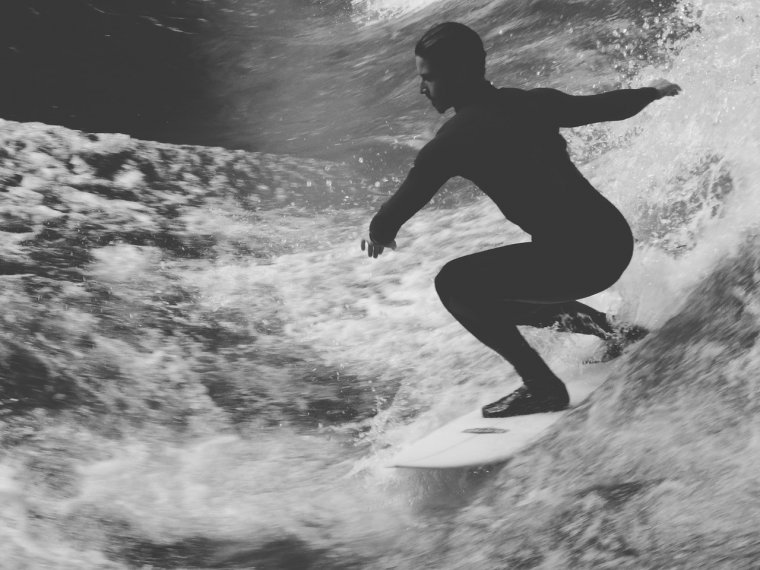
Originally developed by the French photographer Laurent Pujol, the double tow puts the photographer as close to the subject as possible, with one surf board attached to the back of another. This technique revolutionized surf photography, but the unique challenges and demands of double tow photography meant it wasn’t easy to try, let alone develop.
While Laurent Pujol’s original method was great for the bright, natural light of a sunny day, there’s something special about sunrise and sunset for photographers. It’s easy to get great contrast, and there’s something powerful about these brief transitions between day and night. Unfortunately, while surf photographers could still snap pictures from just about anywhere else at these hours, it didn’t seem possible with the double tow technique.
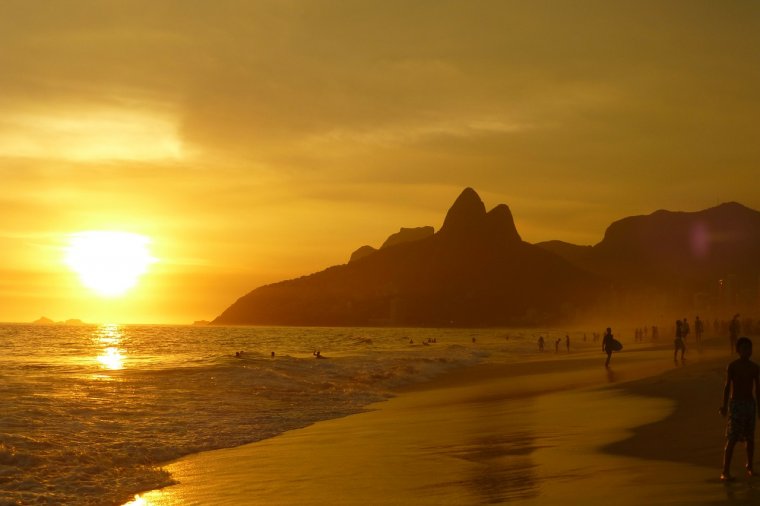
Then Leroy Bellet, a teenage prodigy surf photographer from Australia, decided to get creative with a flash. Working with a camera in bulky waterproof housing is hard enough without adding a flash—with its own giant water housing case—into the equation. Leroy Bellet did it anyway. With the flash, he opened a whole new world of opportunities for double tow photographers. Suddenly, sunset, sunrise, and even nighttime photography were open to surf photographers.
Leroy Bellet and his images are already famous. With the flash in play, he has captured stunning images of surfers leaving glowing tunnels of water into the dark abyss beyond. Vivid red sunsets provide the perfect contrast for the blue waves and black clad surfers in other photos. Each image is unique. Their originality comes from the diversity of lighting and color that comes with the combination of flash and natural light.
The first and greatest challenge of double tow photography is surfing. In order to master double-tow photography, you absolutely must be able to surf. Not only do you have to surf, but you have to surf well. You have to ride well enough to keep steady for shots, and swim clear after the wave breaks. To make matters even more complicated, you must do all of this while hauling around heavy camera gear. Surfing on its own is a pretty dangerous endeavor, but adding a camera to the mix requires a very special set of skills.
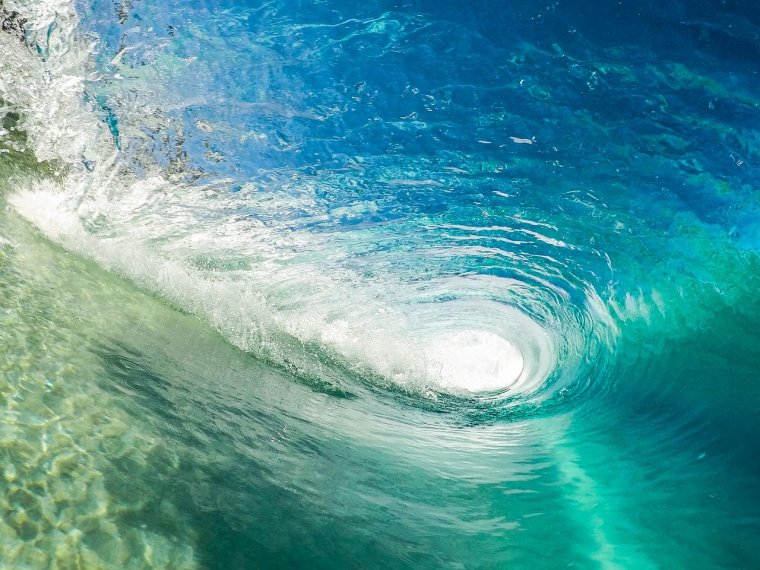
Another great frustration for double tow photographers comes from shifting focus. The predetermined space between professional photographer and subject makes it easy to calculate focal length on shore. Unfortunately, it’s just as easy for even the most advanced cameras to slip and lose focus during a rough tumble through the surf. Bellet had to get creative to ensure his camera stayed focused while it was in its water housing. He decided to start taping the barrel of the lens in place. Putting something sticky on your expensive equipment may sound awful, but this technique has proven itself for double tow photographers.
The last challenge comes in editing, especially for double tow photographers like Bellet who shoot with a flash in dim light. As exciting as the composition may be, viewers still want to see a balanced photo. It takes a lot of time to bring out the background colors of the sky when a bright flash is used against a gleaming wetsuit in the foreground. Double- tow surfers don’t just have to master their shooting techniques, they must also master the fine art of digital photo editing.
Despite all the challenges and risks involved in double tow photography, ambitious souls like Pujol and Bellet will continue to surprise and excite audiences. The innate obstacles of this method limit the number of photographers who can even attempt it, which makes the stunning views all the more inspiring. It’s the most dangerous surf photography technique, but it creates a one-of-a-kind impression.
Small boats can’t get into the waves themselves, but they can provide an elevated angle that, coupled with enough zoom, creates great shots. Unlike the other techniques on this list, shooting from a boat requires relatively little prep and recovery time between shots. It’s also one of the safest ways to photograph surfers. Boats give photographers a lot of mobility, which gives photographers an advantage over shooting from the beach.
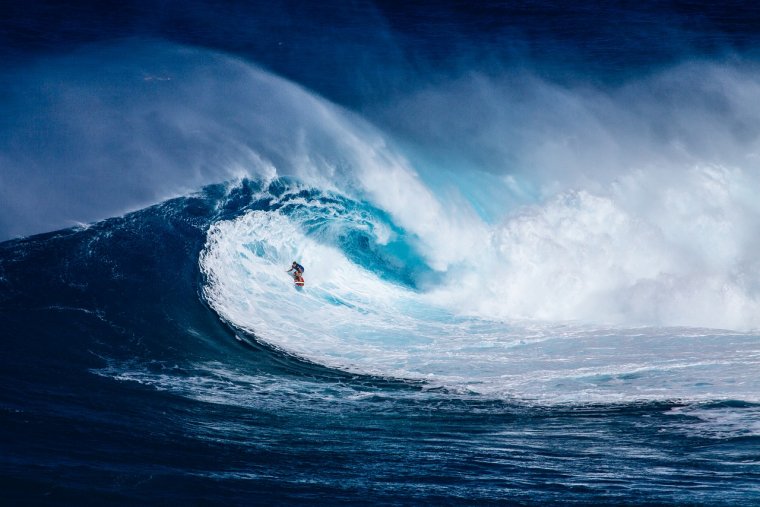
The obvious drawback, of course, is that you have to pay for a boat. Usually only contracted photographers can afford this. Even if you have your own boat, you still need to find someone to captain it while you shoot. Unless you’re a local with connections or a boat of your own, this technique might be too pricey for beginners.
This informal approach to photography is a hands-off technique. Once an action cam is strapped to a surfer’s board, the photographer can’t adjust a single setting. They can’t even tilt the camera to get a better angle. The surfer goes off with the equipment, and the photographer waits for them to return with the footage. This approach is usually better for filming rather than photography, but some surfers who double as photographers have used trial and error to find the best angles for still shots.
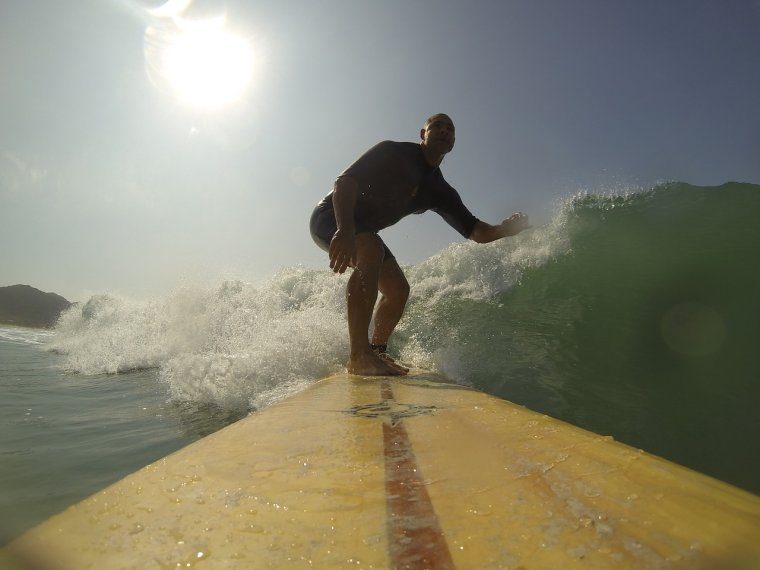
Action cameras don’t produce the same quality images as a DSLR camera, and they are far less versatile. This technique is best used by surfers themselves, since it allows them to capture images without handling a camera while they surf. As these cameras develop, however, it is possible photographers will imagine new and innovative ways to improve on the technique.
Being in the water gives you great access to a variety of shots—of both the surfers and waves. If you paddle out with the surfers, you can go under while they wait for a wave and capture silhouettes from the below. Close-ups and candid moments as the surfers relax on their boards also make great shots. There’s an intimacy to photos taken from the water when surfers are alone between the open ocean and the beach.
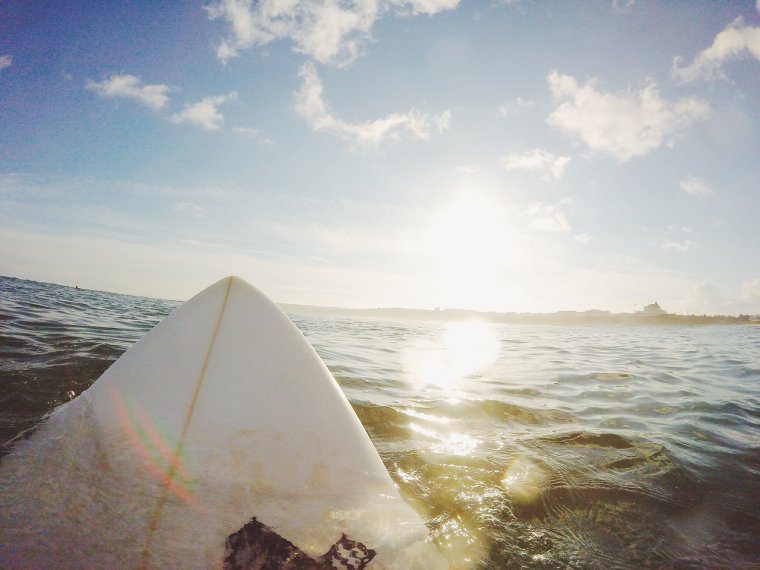
Apart from the double tow technique, this is also the only way to get inside the tube with a surfer. One of the best ways to accomplish this is to wait in the impact zone while the surfer goes out to wait for the swell to break. The wave will bring your subject right to you, and if you time it right, you can get a shot inside the barrel of the wave with a surfer. Obviously, this takes great timing and good waterproof housing. You’ll have a lot of trial and error before you get a successful shot. The results are well worth the wait, though. Unlike double tow images, you get to see the surfer’s face in addition to the interior of the wave.
Shooting from a straight beach provides few options for surf photographers. Fortunately, some of the best surfing spots are in semicircular coves or bays. Photographers can often walk out past the beach to get better vantage points, or even take a small boat or surfboard to rocky outcroppings at the very edge of a bay. Small islands make for great shooting locations, too. Anything that’s safe to stand on can be a shooting location. Changing your elevation by shooting from nearby cliffs and overlooks will diversify your shots, too.
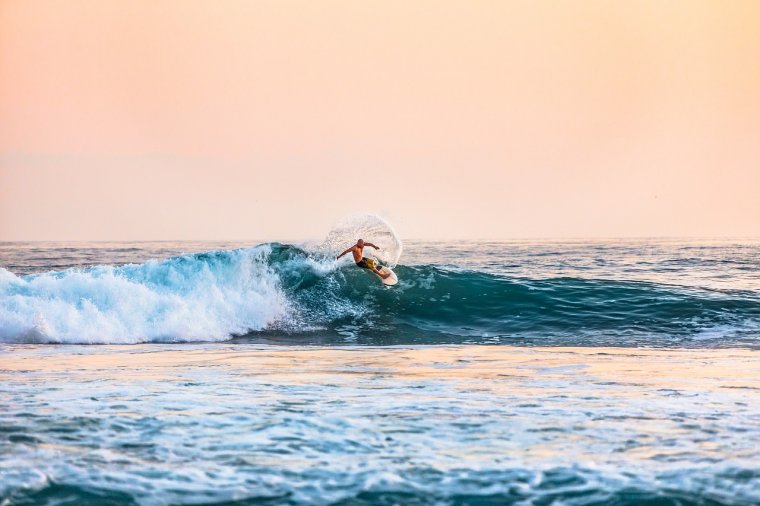
Surf photography is a technically and physically demanding field. It can be as dangerous as it is exhilarating. You share the risks with your subjects, the surfers themselves. Getting the perfect shot of a surfer riding through the barrel of a wave is nothing like regular sports photography. Shooting with surfers requires a unique partnership with the athletes you photograph, and that teamwork will invariably impact the quality of your photos. While it’s always important to work with your subjects, it’s vital to establish a good working relationship with surfers before you try to photograph them hitting the waves.
As we already warned you, surf photography is vastly different from regular sports photography. Photographing sports requires good timing, but you shoot from the sidelines as a spectator. Surf photography often requires photographers to join in the action themselves. It’s usually a struggle to get in the right place at the right time to capture that perfect image. A surfer skimming along the bottom of a barreling wave is a beautiful sight, but it’s also a short one. You cannot get these images alone.
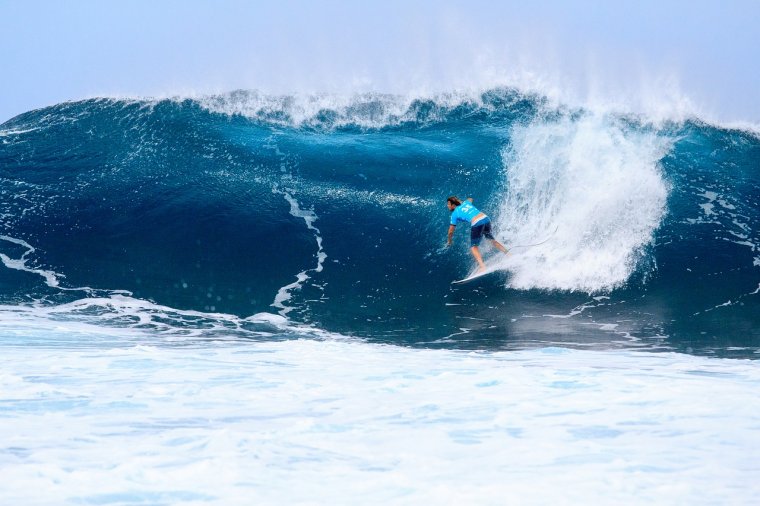
It’s imperative to work with the surfers from the very beginning. Explain what techniques you’re planning, and encourage the surfers to ask questions. If surfers know where you’ll be, they can help you get the best image by speeding up or slowing down as they approach. By involving surfers in the planning process, you also decrease potential sources of frustration. Surfers have to be patient in order to learn their sport. By integrating timing requirements and setting up a plan before hand, it’s easier for surfers to see your needs as a surfing challenge rather than outside interference.
Having a plan is great, but be ready to go with the flow. You never know what the weather may do later in the day, and even if certain beaches usually have great waves, even the ocean has quiet times. Surf photography encompasses more than just shots of surfers on cresting waves. Surfers still have a distinct presence on land, and they make great subjects when they’re just sitting on their boards and waiting for a wave. Surfing is all about patience. Although it’s punctuated by flashes of intense action, surfing has many quiet moments. You should take these opportunities to add variety to your portfolio.
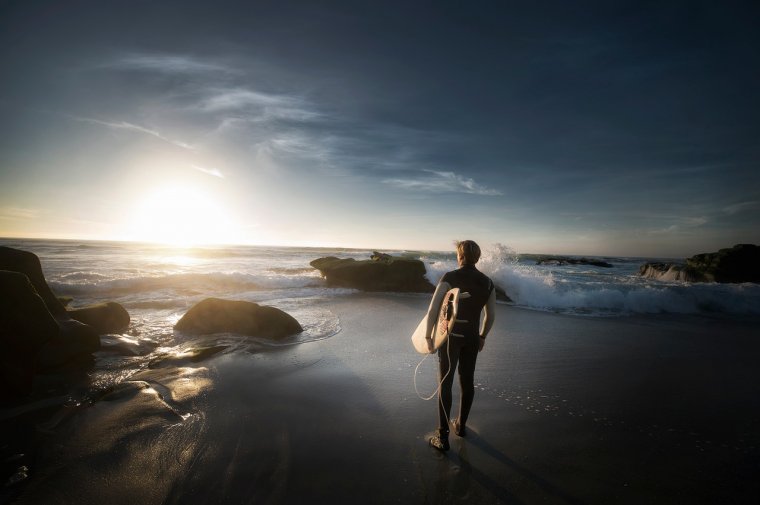
Allow yourself to be creative, especially between major shoots or on slow days. Just because your camera is out of its water housing doesn’t mean it’s time to stop working. Experiment with candid photos or ask your subjects to show you their favorite local areas. You may be surprised how many great surfer shots you can get on land.
Surfers know the best places to surf. They know where and when waves will be at their highest. They know which beaches are crowded and where the surf is just too tough for tourists. Take advantage of this information. Surfers are more than just the subjects of your photographs. They can be your guides if you let them.
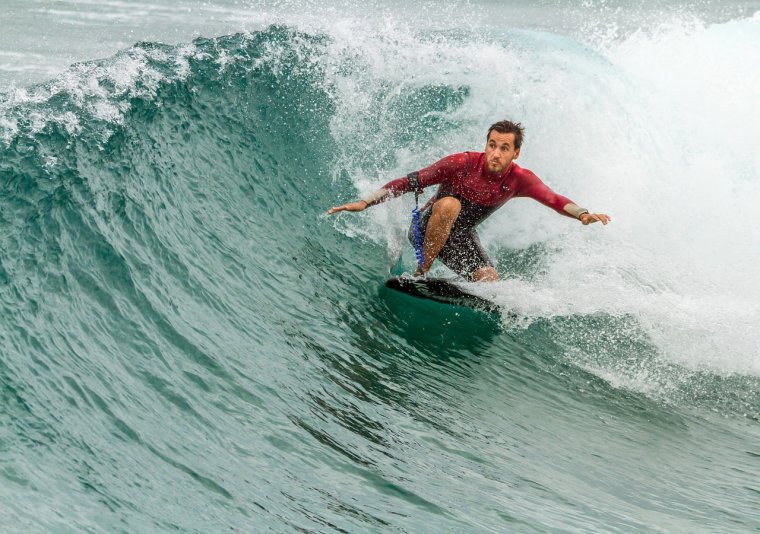
They may even offer some new ideas for composition and lighting. Even if they aren’t professional photographers, chances are they’ve snapped some pictures of their friends in action and recorded great views to show off later. More importantly, they can offer valuable safety advice. For example, if there’s an area of the beach with particularly strong riptides, they can warn you away from that risk.
Depending on your arrangement with the surfer(s), your preferences may come second. Sometimes surfers hire photographers to get pictures they can use when entering competitions or submitting profiles. You can still expand your portfolio, and your subject will likely listen to your professional advice, but remember that the relationship works both ways. Be willing to experiment. Your images can benefit everyone. Even if you are not hired by the surfers themselves, take time to see what images excite them, and plan future shoots accordingly.
Photography and surfing are both serious business, but always remember to have fun. Surfers risk their lives for the rush, and you wouldn’t be attempting surf photography if you weren’t happy to get in the ocean with them. You’ll have a lot of missed opportunities and inevitably get frustrated at times. Remembering to enjoy yourself can prevent that frustration from destroying a productive shoot. You may not get what you want today, but there’s always tomorrow. So long as you have fun, you’ll never see a day as wasted.
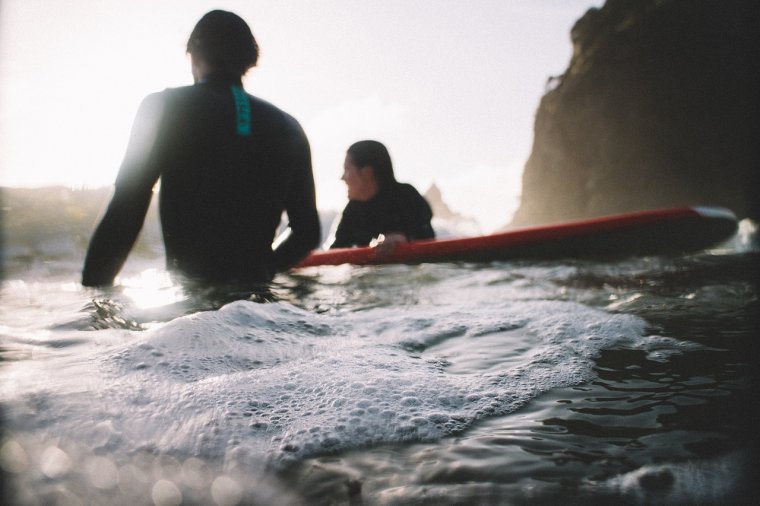
Once you’ve set up your plan and actually gotten in the water with your subjects, everything changes. Surf photography is stunning because it captures moments of intense, rapid action. The waves are breaking, the surfer is moving, and that’s just the action on the surface. Working with surfers is challenging because the pictures you’re trying to take are extremely difficult to capture. That only makes the final images all the more rewarding.
Surfing photography is still a relatively new discipline, and it’s affected by technological advances more than just about any other type of photography. Some techniques require little more than a basic rig and good timing, but the more advanced methods demand serious water housing and surfing talent. Whether you’re a photographer looking to try a new and exciting challenge, or a surfer looking for innovative ways to improve your own photography, there’s a method perfectly suited to your skills.
Comments (0)
There are no comments yet.